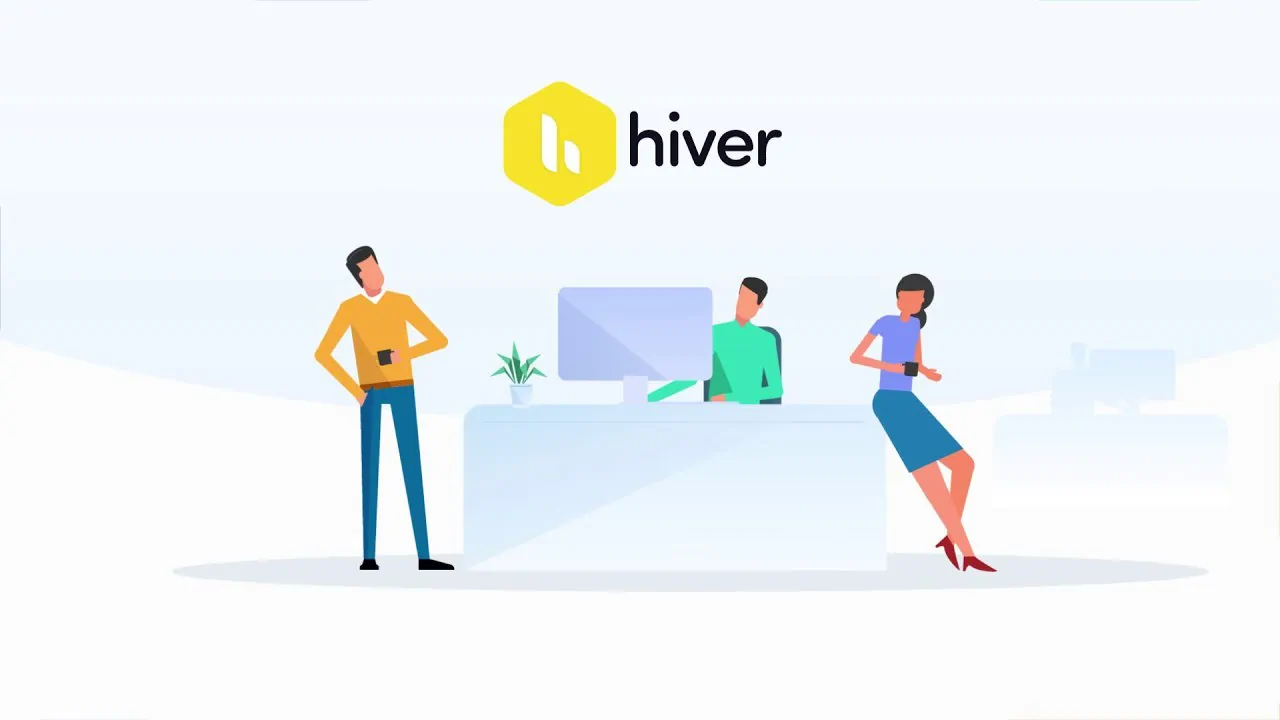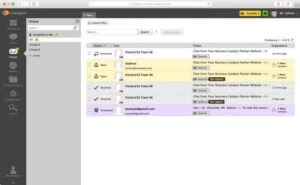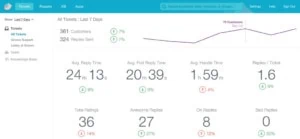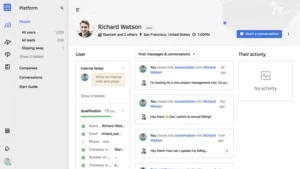Are you looking for a Hiver alternative to boost your customer service? Your search has finally come to a conclusion! Hiver is a simple, low-cost help desk tool that can get you up and running quickly. It can function directly inside your Gmail inbox and has a familiar experience for your team. But the story doesn’t end there. Hiver is a Gmail-only application, thus you won’t be able to use it with any other email client.
Top 10 Best Hiver Alternatives In 2022
In this article, you can know about Hiver alternatives here are the details below;
Email is a valuable customer care channel, but it is not the “only” one. How would you help consumers in real time via live chat or encourage self-service through a knowledge base when customer expectations are at an all-time high? Let’s face it, people are looking for Hiver alternatives because it does not allow you to provide 360-degree support.
We have some fantastic news for you if you’re in the same boat as us!
We prepared a detailed list of the top alternatives after skimming through dozens of software review platforms, product feature pages, and actually utilising the solutions.
But, before we draw any judgments, let’s have a look at the top Hiver alternatives and compare their features and prices.
1. LiveAgent
LiveAgent is predominantly a help desk software that focuses on streamlining the ticket intake and service providing procedures for businesses.
Of course, this is far more intricate than it appears. Essentially, LiveAgent is an all-in-one solution for businesses wishing to set up a call centre, offer live chat through their website and social media channels, and establish a knowledge library for their clients to access at their leisure. Also check task management software
Customer support is also made more fun via LiveAgent, which allows agents to earn “badges” for fulfilling specific customer-related activities as needed. This allows companies to identify high performers while also determining where additional training may be required for some.
Pros of LiveAgent
The key selling point of LiveAgent is that it gives businesses a variety of options to engage and communicate with their customers, from live chat and email to phone and video chat. LiveAgent also offers automated customer care via text and interactive voice response (IVR).
Customer-facing portals from LiveAgent are also fully customisable and brandable, allowing businesses to customise their channels to match their overall brand image. As a result, even as the client seeks extra support, the customer experience gets more simplified. This is another Hiver alternative.
Finally, many users say LiveAgent’s customer service crew is not only quick to respond, but also extremely knowledgeable and helpful. Those that reported problems with the programme were able to swiftly resolve the problem and get back on track.
Cons of LiveAgent
While LiveAgent’s customer care team is quite helpful, some users complain that they need to contact them frequently, particularly during the onboarding process. That is, the software appears to be lacking in proper documentation and instructions for organisations just getting started with the mechanism (especially for less tech-savvy organisations), and despite the fact that LiveAgent’s customer portals are completely customizable, some users report experiencing glitches with certain font and image usage. Some consumers notice that the physical appearance of a ticket or other similar document changes after it is given to them.
Finally, LiveAgent’s mobile app isn’t as robust and streamlined as the desktop version of the software, according to previous users. However, as of August 2018, LiveAgent promises that the team is working on making changes in this area.
2. HappyFox
HappyFox, like LiveAgent, is an all-in-one solution for a company’s help desk software needs.
Users may provide help to their customers via email, live chat, social media, and phone using HappyFox. This allows customer service representatives to reach clients where they want to be reached, making the entire process easier for everyone.
Organizations can also establish a knowledge base with HappyFox, which combines with the tool’s self-service capabilities. HappyFox’s self-service site not only provides information about the content of a customer’s inquiry, but it also allows them to double-check information about the logistics of their problem (e.g., ticket status, previous engagements, etc.).
Pros of HappyFox
As we’ve previously stated, collecting real-time data is critical in order to eliminate agent overlaps and/or service delivery delays; HappyFox users think this is where the solution shines out above the competition. HappyFox’s ticketing and documentation system is streamlined to perfection, despite the fact that it offers a variety of choices for contact between the company and the client.
Additionally, HappyFox tracks and documents all information gathered from clients throughout a support session, allowing enterprises to effortlessly update their knowledge base and other customer-facing content. This also allows businesses to determine whether or not their support staff requires more training.
Finally, HappyFox’s customer service personnel is really knowledgable and friendly. Users say that support staff was either highly hands-on or was just a phone call away during the onboarding process.
Cons of HappyFox
The most common complaint we’ve heard about HappyFox is that it lacks robust features and reports. It’s not so much that reports aren’t detailed, but rather that they aren’t highly adaptable for businesses who want to delve further into their consumers’ information. This is another Hiver alternative.
Furthermore, while many users believe the pricing structure is reasonable for what you get in return, others believe HappyFox is unlikely to be beneficial or inexpensive for firms just starting started. The reason for this is that it necessitates a minimum of three users (which some startups may not have accommodation for at the moment). Furthermore, even the basic version of the tool may have more features than a startup requires right now.
3. Groove
Another Zendesk alternative is Groove, which automates the process of collecting client enquiries and offering support when necessary.
Customer service and assistance can be provided by email, Twitter, Facebook, live chat, phone, and even text message with Groove. Groove also allows several agents to communicate in real time on a single support instance, using both public and private internal channels.
Groove can also be used to develop a knowledge base and a customer portal for businesses. Organizations can use these platforms to deliver information to their clients in the form of text and/or multimedia, allowing them to discover the information they need fast.
Groove also allows customers to design a support widget that can be added to their website. This facilitates the process of connecting with the knowledge base in the first place, as well as allowing clients to open support issues when needed.
The Experts in Groove
Groove’s consumers adore the tool’s simple and easy user interface. Even “their) veteran staff” was able to swiftly grasp the ins and outs of the software and begin utilising it almost immediately, according to one reviewer.
This is another Hiver alternative. Groove customers may also establish custom categories for incoming support issues and set up automations to categorise tickets accordingly, which is a nice feature. Users can specify who in their support team will get tickets related to a certain issue in this way.
The quantity of effective integrations offered by Groove is also worth highlighting. The relief with which consumers were able to migrate data from their present system to Groove’s database has been praised by the majority of users.
Cons of Groove
Groove’s fairly rudimentary reporting tools are the main source of dissatisfaction here. While other reviewers just call Groove’s reporting tools “limited,” one goes so far as to call them “lacklustre.”
Groove’s other major flaw is that its customer-facing portals aren’t completely customisable or brandable. To put it another way, while the content of your knowledge base will be your organization’s, the knowledge base itself will feel like it was built by a different company.
4. AzureDesk
Another help desk software option is AzureDesk, which seeks to “move beyond customer satisfaction to customer joy.”
While several of the platforms we’ve looked at offer a number of communication channels, AzureDesk is primarily focused on email support. AzureDesk assures users that they will be able to track tickets and provide help as needed by integrating with an organization’s contemporary email system.
(AzureDesk also allows users to construct a knowledge base for clients to browse before contacting assistance.)
AzureDesk also allows customers to quickly rank and categorise tickets as they arrive, allowing enterprises to send issues to the most qualified agent for the job. Agents & other team members can also attach private messages to tickets in order to transmit any information that the agent assigned to a particular instance needs to know. This is another Hiver alternative.
Pros of AzureDesk
One of AzureDesk’s key advantages, according to its users, is its straightforward user interface. Essentially, because the paths to certain tools are easy and straightforward, users will have little to no confusion about how to complete a task.
Furthermore, AzureDesk just does not provide more than is required. Rather than allowing users to become engrossed in complex features and functionalities, AzureDesk aims to free enterprises to focus on what matters most: providing customer support.
Finally, AzureDesk’s customer service team is said to be extremely responsive and helpful. As previously expressed, you should have no trouble getting your business up and running with the tool, but if you do, the staff is ready to assist you.
Cons of AzureDesk
While some users may appreciate AzureDesk’s simplicity, other companies may find it lacking in a variety of ways.
Companies searching for a platform to help them give multi-channel support to their clients, for example, will not find AzureDesk useful. This isn’t always a bad thing; the programme wasn’t designed for multi-channel communication.
This is another Hiver alternative. Additionally, for others, the lack of alternatives and complex capabilities may be a turnoff. The tool’s customer-facing fields and forms aren’t highly flexible, and the overall design is quite simple.
Finally, both the depth and breadth of reporting are insufficient. That is, AzureDesk only provides surface-level data on client engagements and exchanges, and it also doesn’t allow users to travel too far back in time to access previously acquired data. As a result, there may be redundancies, missed opportunities, or other customer-facing concerns, causing CX to deteriorate.
5. Zoho Desk
Zoho Desk, like Zendesk, is a universal platform with outstanding integration features and good value for money. Businesses seeking to start with the more complex capabilities will need to acquire a plan straight away. ZoHo Desk suggests a free plan to explore its basic features.
Another advantage of Zoho Desk is that its most costly subscription costs half as much as Zendesk Professional Suite. Because these instruments have nearly identical functionality, they are a more cost-effective option that will not let you down. This is another Hiver alternative.
Many former Zendesk customers have converted to Zoho Desk because of its powerful analytics, billing flexibility for customer service reps, and wide range of integrations.
Pros of Zoho Desk
As previously said, Zoho Desk is a fantastic and more inexpensive alternative to Zendesk for both small and large teams. You can use numerous communication options and make the most of each with its multiple support channels. Also check wayback machine alternatives
Those who have used Zoho Desk will agree that it offers one of the most user-friendly interfaces, making it simple to find what you need. It’s also simple to scale and tweak to meet your specific requirements, making it a great solution for startups.
Cons of Zoho Desk
Many new users report to be confused and overwhelmed when using Zoho Desk due to the tool’s overabundance of features. As a result, the time consumers save by having access to these complex capabilities is frequently spent when attempting to figure out where something is and how it works.
The majority of users who use Zendesk or its alternatives must also write reports. While ZoHo Desk has some good reporting options, the lack of visualisation in reporting is a major drawback.
6. Helpjuice
Of course, our knowledge base software will be at the top of the list. Isn’t it foolish not to? Helpjuice, on the other hand, focuses on allowing users to develop a fully customisable knowledge base that can be used by both internal personnel and customers. This level of customization allows users to match the look and feel of their customer-facing and internal knowledge bases to their brand.
This is another Hiver alternative. In terms of functionality, Helpjuice enables for simultaneous internal editing of knowledge base articles, which means that different agents can work remotely on the same document at the same time.
Agents can also classify and categorise documents as needed, making it easier for clients to find the information they need. Customers can either manually search the knowledge base or use Helpjuice’s sophisticated search features to locate these answers.
Helpjuice also delivers detailed reports and analytics on customer enquiries, allowing users to concentrate on creating content and documentation that would provide more useful information to their consumers. This is another Hiver alternative.
There are a few crucial features to highlight when it comes to what Helpjuice’s customers like best about the software:
- Helpjuice’s user interface is simple, easy to use, and configurable. “Helpjuice does exactly what we ought in the way we want to do it,” says Agilent CrossLab’s Bas van der Brugge.
Why As previously stated, Helpjuice users value the statistics that the tool delivers over time. According to Guidestone’s Steele Ferguson, Helpjuice has helped the company “understand more about how our clients look for things.”
- Helpjuice’s customer service team is laser-focused on getting their customers to where they want to go. “Support is fantastic,” says Van der Brugge once more. We haven’t had many problems, but the team is always quick to answer whenever we contact them.”
Microsoft Sharepoint is a nice document management and storage platform that works seamlessly with all Microsoft Office applications.
While Sharepoint is most commonly used to construct websites for internal teams, it may also be used to develop customer portals and knowledge bases. Sharepoint, like Helpjuice, enables for secure and collaborative document and content editing for both internal and external distribution.
Sharepoint is a simple option for firms wishing to concentrate internal data (e.g., anything from customer-related information to payroll and PTO).
Pros of SharePoint
This is another Hiver alternative. One of Sharepoint’s primary selling features is its emphasis on security, as well as the fact that it can be modified by those with authority from any device and/or location. This implies that papers and other data can be modified “on the fly” at any time.
In addition to interacting with other Microsoft products, Sharepoint also works with a variety of third-party applications. Users should be able to quickly move data from most other software databases to and from Sharepoint.
Finally, as previously said, Sharepoint is easily configurable to meet the demands of the user. In short, if your company requires an internal website for whatever purpose, Sharepoint has you covered.
Cons of SharePoint
On the flipside, Sharepoint users note that the tool essentially necessitates customisation, which often necessitates a deeper technical understanding of how to develop internal webpages.
Furthermore, the Sharepoint learning curve is quite steep. It’s not something you’ll be able to pick up and use because it demands a considerable deal of knowledge with constructing websites in the first place.
In short, Sharepoint isn’t for small, low-tech businesses on a tight budget. Not only that, but larger firms with the resources to run such tech-heavy software are more likely to be able to afford the more extensive solutions we’ll discuss later on this list.
8. Help Scout
Because it offers a variety of services to its users, Help Scout, a help desk and customer care software solution, is a popular Zendesk alternative. This is another Hiver alternative.
Help Scout is first and foremost concerned with “customers, not tickets.” To put it another way, Help Scout simply allows customers to engage with a company’s support team via email in a natural and authentic way. While messages are internally logged as tickets, the customer is never treated as “just a number.”
Help Scout also makes it simple for businesses to track client interactions from the time an internal ticket is opened to the time the issue is resolved. When dealing with a specific customer’s issue, this allows all internal teams to stay on the same page.
Finally, Help Scout allows businesses to develop self-service portals that are accessible to customers. These portals can incorporate knowledge bases and other types of content to assist users in finding answers without having to contact customer service.
Assist the Scouting Pros
This is another Hiver alternative. The key selling point of Help Scout is how simple and intuitive it is to use. Even people who think there is a learning curve for the tool claim that it may be easily surmounted with continuous use.
In line with this, Help Scout’s features and operations are simple and straightforward. There’s no complication for the sake of complexity here; what you see is what you get, and for most users, that’s enough.
Finally, as one would expect from a help desk tool, Help Scout’s customer service and support personnel enjoy a stellar reputation among the company’s users. Support agents are not only quick to provide assistance, but they are also quick to resolve any issues that their users may have. Also check best crm software tools
Scouting Assistance:
Because of its simplicity, Help Scout may not be the best option for individuals looking for a more complex or advanced tool. Help Scout does not match up to Zendesk in terms of being a true alternative (not that it aims to, by any stretch).
Another issue that many customers have reported is that the Help Scout mobile app isn’t up to pace with the desktop version. The mobile version of this tool leaves a lot to be desired, with poor loading times and obvious problems.
When it comes to delayed loading times, several customers have complained that uploading and downloading documents in Help Scout is a real nuisance. Unfortunately, when it comes to real-time information flow, users simply cannot afford the downtime that occasionally occurs.
9. Freshdesk
Another help desk system that focuses on usability and affordability is Freshdesk.
Organizations can use Freshdesk to set up automations to handle specific client inquiries as needed. This comprises automatic routing of help desk tickets to the appropriate department or agent, severity-based prioritisation of questions, and auto-responders for situations where a live response isn’t required. This is another Hiver alternative.
Freshdesk also recognises the need of keeping information and documentation up to date in real time. Agent “collision detection” is built into the programme, guaranteeing that many agents don’t pick up and work on the same query when only one person is needed. Furthermore, information and documentation created by either the customer or the agent may be quickly uploaded “on the fly” to Freshdesk’s knowledge base, allowing for continuous updates.
Pros of Freshdesk
Freshdesk, like Help Scout, is exceptionally simple to use thanks to its simplistic user interface. Freshdesk, despite its simple and uncomplicated style, is a lot more robust solution than the software indicated above, according to many customers.
Freshdesk’s developers continue to test and improve the programme until it is perfected based on user input and other data. Freshdesk users, unlike Zendesk users, continue to see advances in the programme as time passes.
This is another Hiver alternative. It’s also worth mentioning that many Freshdesk customers have remarked on how free the programme is of technical issues. In this case, “no news is a good news,” so people who take a step back and notice how well-organized the programme is says a lot.
Cons of Freshdesk
While the simplicity of Freshdesk is generally regarded as a plus, some users have expressed a desire for additional personalization. This applies to everything from the aesthetics of customer-facing portals to the functionality displayed on internal dashboards, as well as the tool’s reports.
Additionally, some users have experienced minor difficulties with specific automations causing internal messages to be delivered twice. One customer claims that if a ticket is automatically allocated to their department and to them personally, they will receive double emails.
Finally, while the aforementioned collision detection ensures that a single complaint isn’t picked up by numerous agents, users have experienced occasions where a customer submits multiple reports for the same issue, which can cause internal issues if not identified right enough.
10. Intercom
Intercom’s customer messaging platform is designed to help businesses develop genuine relationships with their customers at every level of the sales process.
Users may engage with their customers via Intercom’s live chat, email, in-app messaging, and push notifications. This allows businesses to communicate with the right individuals on the right platform at the right time. This is another Hiver alternative.
Users can also construct in-depth knowledge bases with Intercom. This enables customers to quickly & easily find solutions to both simple and difficult questions without the need for a customer service representative to intervene. Intercom’s messaging services, of course, make it simple for agents to provide assistance when needed.
Intercom sends a report to the company once a client’s issue has been resolved (or has not been resolved). This enables enterprises to revisit their knowledge base and make modifications to individual support materials as needed.
Pros of Intercom
Intercom is said to be exceedingly simple to use by the majority of users. Many reviewers indicate that Intercom allowed them to train their entire workforce in just a few hours.
Furthermore, because Intercom’s software emphasises communication and collaboration, this feature is the tool’s core strength. Not only is customer communication streamlined and efficient, but reviews also indicate that after implementing Intercom, various departments within their organisations were able to maintain much closer lines of contact.
Finally, customers say that both the desktop and mobile versions of Intercom are comparable. This is a significant advantage for Intercom when compared to many of the other tools on this list.
Cons of Intercom
Intercom has been described as a “jack of all trades, master of none” by several reviewers. That is, while the tool has a lot of features and functions, it falls short of the other tools on our list in most areas.
Also, while most customers consider Intercom’s data reporting to be adequate, others feel the programme might offer a little more in this area. For example, at least one user has indicated a wish to be able to read and compare reports from various instances for a single customer, but has had to do it manually.
Finally, some people find Intercom’s price system to be arbitrary and perplexing. Many consumers won’t require the “whole package,” but determining which services they do require (and are ready to pay for) isn’t always straightforward.













